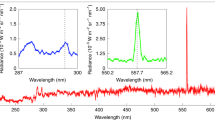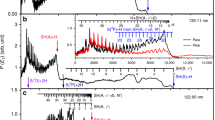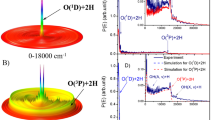Abstract
I PROPOSE here that the transition 3Σ+u → 1Δg in O2 is responsible for previously unidentified features in the nightglow from the Earth's atmosphere, and in observations of radiation emitted from recombining atomic oxygen in the laboratory. The transition violates the approximate selection rules ΔS = 0 and ΔΛ = 0, ±1 (ref. 1); it may be compared with the transition 1Δg → 3Σ−g, which, in addition to violating these selection rules, also violates the rigorous selection rule g←/→g for electric dipole radiation, and so proceeds by magnetic dipole radiation2. The transition 3Σ+u → 1Δg may therefore be significantly stronger than the transition 1Δg → 3Σ−g.
This is a preview of subscription content, access via your institution
Access options
Subscribe to this journal
Receive 51 print issues and online access
$199.00 per year
only $3.90 per issue
Buy this article
- Purchase on Springer Link
- Instant access to full article PDF
Prices may be subject to local taxes which are calculated during checkout
Similar content being viewed by others
References
Herzberg, G., Spectra of Diatomic Molecules, 240–242 (Van Nostrand, New York, 1950).
Van Vleck, J. H., Astrophys. J., 80, 161–170 (1934).
Krupenie, P. H., J. phys. Chem. Ref. Data, 1, 423–534 (1972).
Chamberlain, J. W., Astrophys. J., 121, 277–286 (1955).
Krassovsky, V. I., Shefov, N. N., and Yarin, V. I., Planet. Space Sci., 9, 883–915 (1962).
Hennes, J. P., J. geophys. Res., 71, 763–770 (1966).
Broadfoot, A. L., and Kendall, K. R., J. geophys. Res., 73, 426–428 (1968).
Degen, V., and Nicholls, R. W., J. Phys., B., 2, 1240–1250 (1969).
Chamberlain, J. W., Physics of the Aurora and Airglow, ch. 9 (Academic, New York 1961).
Broida, H. P., and Gaydon, A. G., Proc. R. Soc., A222, 181–195 (1954).
Degen, V., Can. J. Phys., 46, 783–787 (1968).
Chamberlain, J. W., Astrophys. J., 128, 713–717 (1958).
Author information
Authors and Affiliations
Rights and permissions
About this article
Cite this article
WRAIGHT, P. Nightglow and a new band system in molecular oxygen. Nature 263, 310–311 (1976). https://doi.org/10.1038/263310a0
Received:
Accepted:
Issue Date:
DOI: https://doi.org/10.1038/263310a0
Comments
By submitting a comment you agree to abide by our Terms and Community Guidelines. If you find something abusive or that does not comply with our terms or guidelines please flag it as inappropriate.



